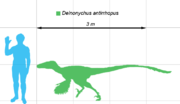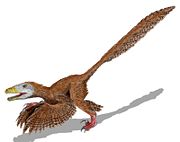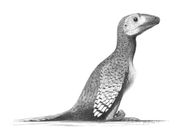Deinonychus
2008/9 Schools Wikipedia Selection. Related subjects: Dinosaurs
| Deinonychus Fossil range: Early Cretaceous |
||||||||||||||||
|---|---|---|---|---|---|---|---|---|---|---|---|---|---|---|---|---|
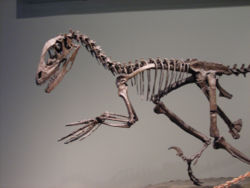 Deinonychus antirrhopus skeleton
|
||||||||||||||||
| Scientific classification | ||||||||||||||||
|
||||||||||||||||
| Species | ||||||||||||||||
|
Deinonychus (pronounced /daɪˈnɒnikəs/) (Greek δεινος, 'terrible' and ονυξ/ονυχος, 'claw') was a genus of carnivorous dromaeosaurid dinosaur. There is one described species, Deinonychus antirrhopus. This 3.4 metre (11 ft) long dinosaur lived during the early Cretaceous Period ( Aptian - Albian stages, 121 to 98.9 million years ago). Fossils have been recovered from the U.S. states of Montana, Wyoming and Oklahoma, though teeth that may belong to Deinonychus have been found much farther east in Maryland.
“Terrible claw” refers to the unusually large, sickle-shaped talon on the second toe of each hind foot, which was probably held up off the ground while the dinosaur walked on the third and fourth toes. It was commonly thought that Deinonychus would kick with the sickle claw to slash at its prey but recent tests on reconstructions of similar Velociraptor talons suggest that the claw was used to stab, not slash. The species name antirrhopus means “counter balance”, which refers to John Ostrom's idea about the function of the tail. As in other dromaeosaurids, the tail vertebrae have a series of ossified tendons and super - elongated bone processes. These features seemed to make the tail into a stiff counterbalance, but a fossil of the very closely related Velociraptor mongoliensis (IGM 100/986) has an articulated tail skeleton that is curved laterally in a long S – shape. This suggests that, in life, the tail could swish to the sides with a high degree of flexibility In both the Cloverly and Antlers Formation, Deinonychus remains have been found closely associated with those of the ornithopod Tenontosaurus. Teeth discovered associated with Tenontosaurus specimens imply it was hunted or at least scavenged upon by Deinonychus.
Paleontologist John Ostrom's study of Deinonychus in the late 1960s revolutionized the way scientists thought about dinosaurs, igniting the debate on whether or not dinosaurs were warm-blooded. Before this, the popular conception of dinosaurs had been one of plodding, reptilian giants. Ostrom noted lightweight bones and raptorial claws on the feet, which revealed an active, agile predator.
Description
Based on the largest known specimens, Deinonychus could reach 3.4 meters (11.1 ft), with a maximum skull length of 410 mm (16.4 in), a hip height of 0.87 meters (2.85 ft), a maximum weight of 73 kilograms (161 lb). Its skull was equipped with powerful jaws lined with around sixty curved, blade-like teeth. Studies of the skull have progressed a great deal over the decades. Ostrom reconstructed the partial, imperfectly preserved, skulls that he had as triangular, broad, and fairly similar to Allosaurus. Additional Deinonychus skull material and closely related species found with good 3D preservation show that the palate was more vaulted than Ostrom thought, making the snout far narrower, while the jugals flared broadly, giving greater stereoscopic vision. The skull of Deinonychus was different from that of Velociraptor, however, in that it had a more robust skull roof like that of Dromaeosaurus, and did not have the depressed nasals of Velociraptor. Both the skull and the lower jaw had fenestrae (skull openings) which reduced the weight of the skull. In Deinonychus, the antorbital fenestra, a skull opening between the eye and nostril, was particularly large.
Like all dromaeosaurs, Deinonychus possessed large hands ( manus) with three claws on each forelimb. The first digit was shortest and the second was longest. Each hind foot bore a sickle-shaped claw on the second digit, which was probably used during predation.
Classification
Deinonychus is one of the best-known dromaeosaurids, and is a close relative of the smaller Velociraptor, found in younger, Late Cretaceous-age rock formations in Central Asia. The clade they form is called Velociraptorinae. The subfamily name Velociraptorinae was first coined by Rinchen Barsbold in 1983 and originally contained the single genus Velociraptor. Later Phil Currie included most of the dromaeosaurids. Two Late Cretaceous genera, Tsaagan from Mongolia and the North American Saurornitholestes, may also be close relatives, but the latter is poorly known and hard to classify. Velociraptor and its allies are regarded as using their claws more than their skulls as killing tools, as opposed to dromaeosaurids like Dromaeosaurus with stockier skulls. Together with the troodontids, the dromaeosaurids form the Deinonychosauria clade which is a sister taxon of aves. Phylogenetically, the Deinonychosauria represent the group of non-avian dinosaurs the most closely related to birds.
Discovery and naming
Fossilized remains of Deinonychus have been recovered from the Cloverly Formation of Montana and Wyoming and in the Antlers Formation of Oklahoma, in North America. Additionally, teeth found in the Arundel Clay Facies (Aptian), of the Potomac Formation on the Atlantic Coastal Plain of Maryland may be assigned to the genus.
The first remains were uncovered in 1931 in southern Montana near the town of Bridger. The team leader, paleontologist Barnum Brown, was primarily concerned with excavating and preparing the remains of the ornithopod dinosaur Tenontosaurus, but in his field report from the dig site to the American Museum of Natural History, he reported the discovery of a small carnivorous dinosaur close to a Tenontosaurus skeleton, "but encased in lime difficult to prepare." He informally called the animal "Daptosaurus" and made preparations for describing it and having the skeleton put on display, but never finished this work. Brown brought back from the Cloverly Formation the skeleton of a smaller theropod with seemingly oversized teeth that he informally named "Megadontosaurus". John Ostrom, reviewing this material decades later, realized that the teeth came from Deinonychus, but the skeleton came from a completely different animal. He named this skeleton Microvenator.
A little more than thirty years later, in August of 1964, paleontologist John Ostrom led an expedition from Yale University’s Peabody Museum which discovered more skeletal material. Expeditions during the following two summers uncovered more than 1000 bones, among which were at least three individuals. Since the association between the various recovered bones was weak, making the exact number of individual animals represented impossible to determine properly, the type specimen (YPM 5205) of Deinonychus was restricted to the complete left foot and partial right foot that definitely belonged to the same individual. The remaining specimens were catalogued in fifty separate entries at Yale's Peabody Museum of Natural History.
Later study by Ostrom and Grant E. Meyer analyzed their own material as well as Brown's "Daptosaurus" in detail and found them to be the same species. Ostrom published his findings in 1969, giving all the referred remains the new name of Deinonychus antirrhopus. "antirrhopus" means "counterbalancing" and refers to the likely purpose of a stiffened tail.
Though a myriad of bones was available by 1969, many important ones were missing or hard to interpret. There were few postorbital skull elements, no femurs, no sacrum, no furcula or sternum, missing vertebrae, and (Ostrom thought) only a tiny fragment of a coracoid. Ostrom’s skeletal reconstruction of Deinonychus included a very unusual pelvic bone – a pubis which was trapezoidal and flat, unlike that of other theropods, but which was the same length as the ischium and which was found right next to it.
Further findings
In 1974 Ostrom published another monograph on the shoulder of Deinonychus in which he realized that the pubis that he had described was actually a coracoid – a shoulder element. In that same year, another specimen of Deinonychus was excavated in Montana by a Harvard University expedition headed by Farish Jenkins. This discovery added several new elements; well preserved femurs, pubes, a sacrum, and better ilia, as well as elements of the pes and metatarsus. Ostrom described this specimen and revised his skeletal restoration of Deinonychus. This time it showed the very long pubes, and Ostrom began to suspect that they may have even been a little retroverted like those of birds.
A skeleton of Deinonychus including bones from the original (and most complete) specimen can be seen on display at the American Museum of Natural History, with another specimen on display at the Museum of Comparative Zoology at Harvard University. The American Museum and Harvard specimens are from a different locality than the Yale specimens. Even these two skeletal mounts are lacking elements including the sterna, sternal ribs, furcula, and gastralia.
Even after all of Ostrom’s work, several small blocks of lime-encased material remained unprepared in storage at the American Museum. These consisted mostly of isolated bones and bone fragments, including the original matrix, or surrounding rock in which the specimens were initially buried. An examination of these unprepared blocks by Gerald Grellet-Tinner and Peter Makovicky in 2000 revealed an interesting, overlooked feature. Several long, thin bones identified on the blocks as ossified tendons (structures which helped stiffen the tail of Deinonychus) turned out to actually represent gastralia (abdominal ribs). More significantly, a large number of previously unnoticed fossilized eggshells were discovered in the rock matrix which had surrounded the original Deinonychus specimen.
In a subsequent, more detailed report on the eggshells, Grellet-Tinner and Makovicky concluded that the egg almost certainly belonged to Deinonychus, representing the first dromaeosaurid egg to be identified. Moreover, the external surface of one eggshell was found in close contact with the gastralia suggesting that Deinonychus might have brooded its eggs. This implies that Deinonychus used body heat transfer as a mechanism for egg incubation, and indicates an endothermy similar to modern birds. Further study by Gregory Erickson and colleagues finds that this individual was 13 or 14 years old at death and its growth had plateaued. Unlike other theropods in their study of specimens found associated with eggs or nests, it had finished growing at the time of its death.
Implications
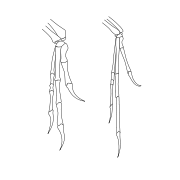
The description in 1969 by Ostrom of Deinonychus has been described as the most important single discovery of dinosaur paleontology in the mid 20th century. The discovery of this clearly active, agile predator did much to change the scientific (and popular) conception of dinosaurs and opened the door to speculation that dinosaurs may have been warm-blooded. This development has been termed the Dinosaur renaissance. Several years later, Ostrom noted similarities between the forefeet of Deinonychus and that of birds, which observation led him to revive the hypothesis that birds are descended from dinosaurs. Thirty years later, this idea is almost universally accepted.
Deinonychus almost certainly was feathered, since its close relative Velociraptor was shown in 2007 to have been feathered, based on the presence of quill knobs on the forearm. Such knobs show where feathers anchor in modern birds. This recent discovery added weight to already strong theories that all dromaeosaurids were feathered.
Paleobiology and paleoecology
Geological evidence suggests that Deinonychus inhabited a floodplain or swamplike habitat. The paleoenvironment of both the Cloverly Formation and the Antlers Formation, in which remains of Deinonychus have been found, consisted of forests, deltas and lagoons, not unlike today's Louisiana. Other animals Deinonychus shared its world with include herbivorous dinosaurs such as the armoured Sauropelta and the ornithopods Zephyrosaurus and Tenontosaurus. In Oklahoma, the ecosystem of Deinonychus also included the large theropod Acrocanthosaurus, the huge sauropod Sauroposeidon, the crocodilian Goniopholis, and the gar Lepisosteus.If the teeth found in Maryland are those of Deinonychus, then its neighbors would include Astrodon, Dryptosaurus and a nodosaur (called Priconodon) only known from teeth.
Predatory behaviour
Deinonychus teeth found in association with fossils of the ornithopod dinosaur Tenontosaurus are quite common in the Cloverly Formation. Two quarries have been discovered that preserve fairly complete Deinonychus fossils near Tenontosaurus fossils. The first, the Yale quarry in the Cloverly of Montana, includes numerous teeth, four adult Deinonychus and one juvenile Deinonychus. The association of this number of Deinonychus skeletons in a single quarry suggests that Deinonychus may have fed on that animal, and perhaps hunted it. Ostrom and Maxwell have even used this information to speculate that Deinonychus might have lived and hunted in packs. The second such quarry is from the Antlers formation of Oklahoma. The site contains six partial skeletons of Tenontosaurus of various sizes, along with one partial skeleton and many teeth of Deinonychus. One tenontosaur humerus even bears what might be Deinonychus tooth marks. Brinkman et al. (1998) point out that Deinonychus had an adult mass of 70-100 kilograms, whereas adult tenontosaurs were 1-4 metric tons. A solitary Deinonychus could not kill an adult tenontosaur, suggesting that pack hunting is possible.
A recent study by Roach and Brinkman has called into question the cooperative pack hunting behaviour of Deinonychus, based on what is known of modern carnivore hunting and the taphonomy of tenontosaur sites. Modern archosaurs (birds and crocodiles) and komodo dragons display little cooperative hunting; instead, they are usually either solitary hunters, or are drawn to previously-killed carcasses, where much conflict occurs between individuals of the same species. For example, in situations where groups of komodo dragons are eating together, the largest individuals eat first and will attack smaller komodos that attempt to feed; if the smaller animal is killed, it is cannibalized. When this information is applied to the tenontosaur sites, it appears that what is found is consistent with Deinonychus having a komodo- or crocodile-like feeding strategy. Deinonychus skeletal remains found at these sites are from subadults, with missing parts consistent with having been eaten by other Deinonychus.
Limb function
Despite being the most distinctive feature of Deinonychus, the shape and curvature of the sickle-claw varies between specimens. The type specimen described by Ostrom in 1969 has a strongly curved sickle claw, while a newer specimen described in 1976 had a claw with much weaker curvature, more similar in profile with the 'normal' claws on the remaining toes. Ostrom suggested that this difference in the size and shape of the sickle claws could be due to individual, sexual, or age-related variation.
Ostrom originally speculated that Deinonychus gripped its prey with the talons of the forelimbs while delivering disemboweling slashes with its sickle claws. Later studies, however, have shown that the sickle claws were not used to slash but rather to deliver small stabs to the victim, possibly indicating their use as crampon-like climbing tools. Biomechanical studies by Ken Carpenter in 2002 confirmed that the most likely function of the forelimbs in predation was grasping, as their great lengths would have permitted longer reach than for most other theropods. The rather large and elongated coracoid, hinting for powerful muscles in the forelimbs, further strengthened this interpretation. Carpenter's biomechanical studies using bones casts also showed that Deinonychus could not fold its arms against its body like a bird ("avian folding"), contrary to what was inferred from the earlier 1985 descriptions by Jacques Gauthier and Gregory S. Paul in 1988.
Studies by Phil Senter in 2006 indicated that Deinonychus forelimbs could be used not only for grasping but also for clutching objects towards the chest. The likely presence of large wing feathers in Deinonychus, however, would have limited the range of motion of the forelimbs to some degree. For example, when Deinonychus extended its arm forward, the 'palm' of the hand automatically rotated to an upward-facing position. This would have caused one wing to block the other if both forelimbs were extended at the same time, leading Senter to conclude that clutching objects to the chest would have only been accomplished with one arm at a time. The function of the fingers would also have been limited by feathers; for example, only the third digit of the hand could have been employed in activities such as probing crevices for small prey items, and only in a position perpendicular to the main wing. Alan Gishlick, in a 2001 study of Deinonychus forelimb mechanics, found that even if large wing feathers were present, the grasping ability of the hand would not have been significantly hindered; rather, grasping would have been accomplished perpendicular to the wing, and objects likely would have been held by both hands simultaneously in a "bear hug" fashion, finding which have been supported by the later forelimb studies by Carpenter and Senter.
Parsons has shown that juvenile and sub-adult specimens of Deinonychus display some morphological differences with the adults. For instance, the arms of the younger specimens were proportionally longer than those of the adults, a possible indication of difference in behaviour between young and adults.
Speed
Dromaeosaurids, especially Deinonychus, are often depicted as unusually fast-running animals in the popular media, and Ostrom himself speculated that Deinonychus was fleet-footed in his original description. However, when first described, a complete leg of Deinonychus had not been found, and Ostrom's speculation about the length of the femur (upper leg bone) later proved to have been an overestimate. In a later study, Ostrom noted that the ratio of the femur to the tibia (lower leg bone) is not as important in determining speed as the relative length of the foot and lower leg. In modern, fleet-footed birds like the ostrich, the foot-tibia ratio is .95. In unusually fast-running dinosaurs like Struthiomimus, the ratio is .68, but in Deinonychus, the ratio is .48. Ostrom stated that the "only reasonable conclusion" is that Deinonychus was not particularly fast compared to other dinosaurs, and certainly not as fast as modern flightless birds.
The low foot to lower leg ratio in Deinonychus is due partly to an unusually short metatarsus (upper foot bones). The ratio is actually larger in smaller individuals than in larger ones. Ostrom suggested that the short metatarsus may be related to the function of the sickle claw, and used the fact that it appears to get shorter as individuals aged as support for this. He interpreted all these features – the short second toe with enlarged claw, short metatarsus, etc. – as support for the use of the hind leg as an offensive weapon, where the sickle claw would strike downwards and backwards, and the leg pulled back and down at the same time, slashing and tearing at the prey. Ostrom suggested that the short metatarsus reduced overall stress on the leg bones during such an attack, and interpreted the unusual arrangement of muscle attachments in the Deinonychus leg as support for his idea that a different set of muscles were used in the predatory stroke than in walking or running. Therefore, Ostrom concluded that the legs of Deinonychus represented a balance between running adaptations needed for an agile predator, and stress-reducing features to compensate for its unique foot weapon.
In his 1981 study of Canadian dinosaur footprints, Richard Kool produced rough walking speed estimates based on several track-ways made by different species in the Gething Formation of British Columbia. Kool estimated one of these track-ways, representing the ichnospecies Irenichnites gracilis (which may have been made by Deinonychus), to have a walking speed of 10.1 kilometers per hour (6 miles per hour).
Eggs
The identification in 2000 of a probable Deinonychus egg associated with one of the original specimens allowed comparison with other theropod dinosaurs in terms of egg structure, nesting, and reproduction. In their 2006 examination of the specimen, Grellet-Tinner and Makovicky examined the possibility that the dromaeosaurid had been feeding on the egg, or that the egg fragments had been associated with the Deinonychus skeleton by coincidence. They dismissed the idea that the egg had been a meal for the theropod, noting that the fragments were sandwiched between the belly ribs and forelimb bones, making it impossible that they represented contents of the animal's stomach. In addition, the manner in which the egg had been crushed and fragmented indicated that it had been intact at the time of burial, and was broken by the fossilization process. The idea that the egg was randomly associated with the dinosaur were also found to be unlikely; the bones surrounding the egg had not been scattered or disarticulated, but remained fairly intact relative to their positions in life, indicating that the area around and including the egg was not disturbed during preservation. The fact that these bones were belly ribs ( gastralia), which are very rarely found articulated, supported this interpretation. All the evidence, according to Grellet-Tinner and Makovicky, indicates that the egg was intact beneath the body of the Deinonychus when it was buried. It is possible that this represents brooding or nesting behaviour in Deinonychus similar to that seen in the related troodontids and oviraptorids, or that the egg was in fact inside the oviduct when the animal died.
Examination of the Deinonychus egg's microstructure confirms that it belonged to a theropod, since it shares characteristics with other known theropod eggs and shows dissimilarities with ornithischian and sauropod eggs. Compared to other maniraptoran theropods, the egg of Deinonychus is more similar to those of oviraptorids than to those of troodontids, despite studies which show the latter are more closely related to dromaeosaurids like Deinonychus. While the egg was too badly crushed to accurately determine its size, Grellet-Tinner and Makovicky estimated a diameter of about 7 cm (2.7 in) based on the width of the pelvic canal through which the egg had to have passed. This size is similar to the 7.2 cm diameter of the largest Citipati (an oviraptorid) eggs; Citipati and Deinonychus also shared the same overall body size, supporting this estimate. Additionally, the thicknesses of Citipati and Deinonychus eggshells are almost identical, and since shell thickness correlates with egg volume, this further supports the idea that the eggs of these two animals were about the same size.
